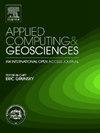评估海上风电场地面建模的古通道概率——多点统计和顺序指标模拟的比较
IF 3.2
Q2 COMPUTER SCIENCE, INTERDISCIPLINARY APPLICATIONS
引用次数: 0
摘要
利用地质统计学方法对海上风电场开发区域概率地面模拟中埋藏古河道的预测进行了研究。这些通道在北海等冰川区很常见,可能会对涡轮机基础的稳定性造成重大的地质危害。传统的二维地震数据解释提供了最佳的位置估计,但缺乏概率评估,特别是在未勘探的位置。采用多点统计(MPS)和顺序指标模拟(SIS)来量化地震数据中远离地震线的通道特征的概率。MPS利用训练图像来捕捉复杂的空间结构,而SIS则依靠变异函数模型来模拟空间变异性。结果表明,较密集的地震线间距(150 m)比较宽的地震线间距(300 m和600 m)具有更高的精度,这强调了数据密度在海上地下场地表征中的重要性。此外,研究结果表明,MPS提供了更低的误差,使其更适合精确的通道位置预测。所选择的训练图像对测试数据的结果没有重大影响。相反,SIS提供了更广泛的潜在渠道位置覆盖范围,这可能有利于进一步降低风险。这项研究通过结合概率方法,有助于更明智的地面建模。因此,它通过在风电场开发的早期阶段增强对地下的了解来支持海上风电场的现场开发,以帮助风电场的决策和进一步的现场调查规划。本文章由计算机程序翻译,如有差异,请以英文原文为准。
Assessing paleo channel probability for offshore wind farm ground modeling - comparison of multiple-point statistics and sequential indicator simulation
The presented study investigates the prediction of buried paleo-channels for probabilistic ground modeling of offshore windfarm development areas using geostatistical methods. These channels, common in glaciogenic regions like the North Sea, can pose significant geohazards affecting turbine foundation stability. Conventional 2D seismic data interpretation provides the best estimate of the position but lacks probabilistic assessment, specifically at unexplored locations. Multiple-point statistics (MPS) and sequential indicator simulation (SIS) are applied to quantify the probability of channel features from seismic data, away from seismic lines. MPS utilizes training images to capture complex spatial structures, while SIS relies on variogram models for modeling spatial variability. Results demonstrate that denser seismic line spacing (150 m) yields higher accuracy compared to wider spacings (300 m and 600 m), underscoring the importance of data density in offshore subsurface site characterization. Additionally, the findings indicate that MPS provides lower errors, making it preferable for precise channel location prediction. The selected training image did not have a major impact on the outcome on the tested data. Conversely, SIS offers broader coverage of potential channel locations, which may be advantageous for further de-risking. This research contributes to more informed ground modeling by incorporating probabilistic approaches. Therefore, it supports in offshore wind farm site development by enhancing knowledge of the subsurface at an early stage of wind farm development to aid decisions in windfarm and further site investigation planning.
求助全文
通过发布文献求助,成功后即可免费获取论文全文。
去求助
来源期刊

Applied Computing and Geosciences
Computer Science-General Computer Science
CiteScore
5.50
自引率
0.00%
发文量
23
审稿时长
5 weeks
 求助内容:
求助内容: 应助结果提醒方式:
应助结果提醒方式:


